- Home
- Introduction
- Website News
- Postscript Magazines
- British History
- Company History
- British Products
- British History National Cash Register Co. Ltd., 1896 - 1900
- NCR Films
- NCR Vintage Products
- Divisions
- NCR Newscast Tapes.
- Personalities
- The National Cash Register Company Ltd. 1896-1900
- Circuit News - Field Engineering
- Patterson Obituary
- Vintage Cash Register Service Aids2
Marylebone 1936 -
THE NEW HEADQUARTERS
As planned and described by the Architects, J. STANLEY BEARD, F.R.I.B.A. and WALTER R. BENNETT, L.R.I.B.A.
This building has been designed to accommodate a large and important commercial company, and owing to the very specialist nature of this firm's productions the conception of the design proved both intricate and interesting.
The problem of design was to provide a building which would prove efficient in its internal arrangements and at the same time be of such a dignified design as befits its important situation in Marylebone Road.
The nature of the business to be conducted in this building required that a certain circulation of goods and a sequence of operations should have first consideration. This necessitated the workshops and trade sections of the building being positioned on the upper floors, whilst' the lower floors were used for showrooms, demonstration rooms and administrative offices.
The nature of the business to be conducted in this building required that a certain circulation of goods and a sequence of operations should have first consideration. This necessitated the workshops and trade sections of the building being positioned on the upper floors, whilst' the lower floors were used for showrooms, demonstration rooms and administrative offices.
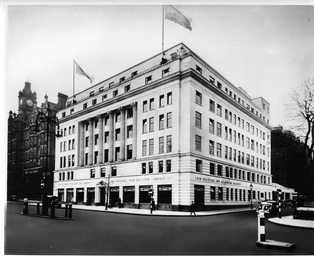
In consequence of this requirement very heavy loads are imposed upon the fourth to sixth floors inclusive, as these are laid out as workshops, printing department with heavy running plant, plating and enamelling departments, repair and assembling shops, photographic department, heavy storage spaces, and in one case a paper slitting department which requires a storage of large rolls of paper.
The question of circulation had to be most carefully considered, and fast and powerful goods and passenger lifts are installed to deal with the vertical circulation through all departments.
The main showroom was required to be on the ground floor and to be entered from Marylebone Road.
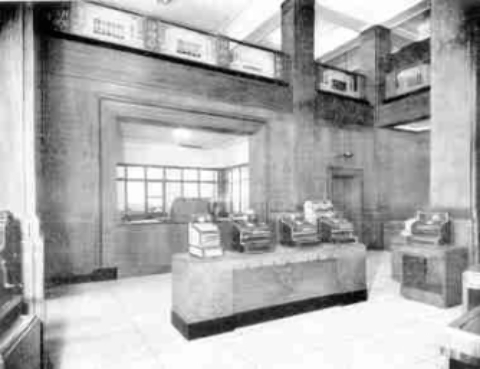
The Main Showroom
This showroom is 65' 0" long by 45' 0" wide and extends in height through two storeys. At first floor level the sides of the show room are set back and an open balcony is provided, the balustrade of which is constructed of bronze and etched glass with internal illumination.
A Corner of The Main Showroom
The architectural treatment of the showroom and main' stairs has been kept to simple plain surfaces in French walnut flush panelling, whilst the flooring is in quarzite with ebonite jointing.
Opening off the main showroom and also off the balcony are numerous rooms which are used for the demonstration of cash registers and accounting machines. These rooms have been treated acoustically to obviate all undue noise.
The Main Showroom
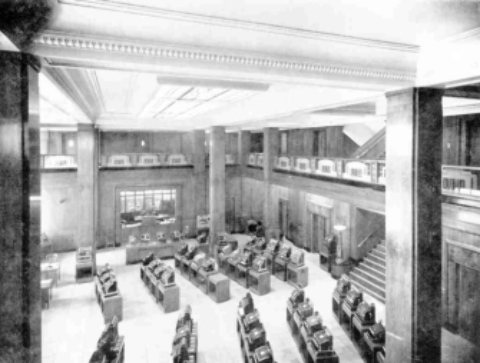
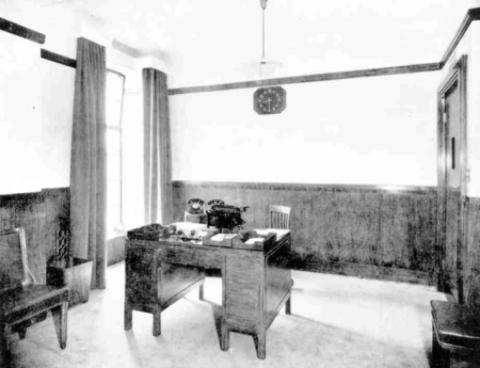
On the second and third floors are extensive suites of administrative and executive offices, and also a further showroom for accounting machines. The principal executive offices are panelled in French walnut in a similar style to the design of the main showroom
The Managing Director's Office
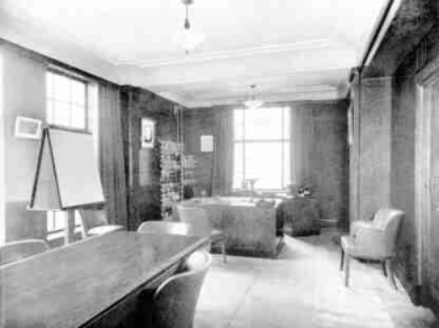
The convention hall is entered from a foyer approached from the main showroom.
Beyond the main block of buildings is a covered garage and loading dock.
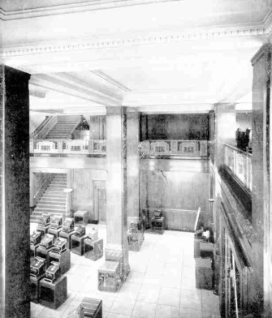
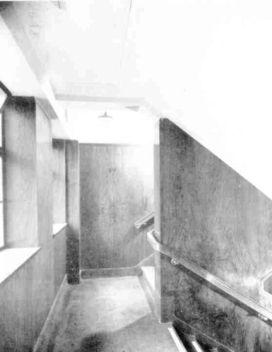
The Main Staircase
The equipment of the building is essentially up-to-date in every respect. Air conditioning is provided to all principal floors and is described in detail in this publication. Personal call installations, fast and fully automatic lifts, loud-speaker, internal telephones, etc'., etc., all go to provide a most compete equipment.
The general architectural treatment of the exterior has been kept to a restrained classical style. The main facade fronting on Marylebone Road is faced in natural Portland stone, the lower portion of the elevation having the stone courses rusticated to give an appearance of additional strength and interest, and to form the base for the classical colonnade of the six three-quarter fluted columns of the Roman Corinthian order which are the central feature of the main facade.
The columns forming this colonnade are 30' 0" in height and embrace three storeys. Above is the full entablature of the Corinthian order. The sixth floor above is set back from the main face of, the building, the chief ornament of this portion being the carved and moulded cartouches at the returns and the bronze flagpole bosses and flagpoles.
The return facades' to both Great Central Street and Balcombe Street are faced with artificial Portland stone, the architectural treatment being in keeping with the front facade.
Steelwork
This building is built of fireproof materials throughout, and is constructed with a complete Steel frame so that the whole load of floors and walls is carried direct by steel beams and columns to the foundations. None of, the walls are carrying anything but their own weight, as by this means any portion of the walls and floors can be removed or modified without detriment to the structure. The steel used is the best quality of British Manufacture, and its fabrication into the various members for the structure was done by British Labour. The floors are of reinforced concrete and hollow tile construction being thus fireproof and affording the maximum of strength with a minimum of weight.
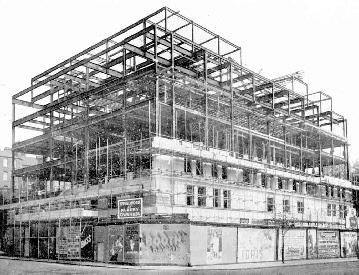
The upper floors of the building are devoted to the assembly of Cash Registers and Accounting Machines, and are heavily constructed to bear the weight of printing presses, guillotine, drop hammers and other heavy plant. There are also spaces on these floors for storage of materials and finished products, which are all of a heavy nature.
This building is built of fireproof materials throughout, and is constructed with a complete Steel frame so that the whole load of floors and walls is carried direct by steel beams and columns to the foundations. None of the walls are carrying anything but their own weight, as by this means any portion of the walls and floors can be removed or modified without detriment to the structure. The steel used is the best quality of British Manufacture, and its fabrication into the various members for the structure was done by British Labour. The floors are of reinforced concrete and hollow tile construction being thus fireproof and affording the maximum of strength with a minimum of weight.
The upper floors of the building are devoted to the assembly of Cash Registers and Accounting Machines, and are heavily constructed to bear the weight of printing presses, guillotine, drop hammers and other heavy plant. There are also spaces on these floors for storage of materials and finished products, which are all of a heavy nature.
The number of internal columns has been reduced to a minimum in order to facilitate the allocation of departments, and 40 feet span girders were adopted to give a spacious unobstructed area for the main showroom on the ground floor. These girders' weigh 7 tons each.
The Site
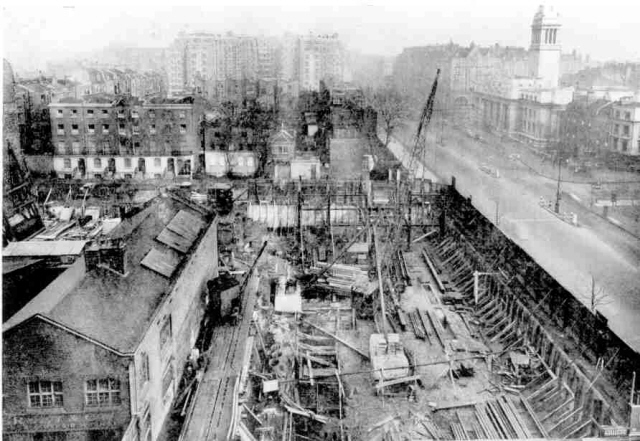
Provision has also been made in the structure for the possibility of extension of the premises by making allowance for additional load on the columns on the northern side where the present garage and loading dock is situated.
An interesting problem arose through leaving this space for development, as temporary support had to be given to the adjoining buildings until the contemplated extension butted against them and took the place of the' previous buildings which had been demolished. This was achieved by reinforced concrete buttresses with beams between them, at each floor, so, that the whole exposed surface of the wall was adequately stiffened.
As the loads imposed by this building and its usage were exceptionally heavy, it was not possible to found the building on the very fine sand which overlays the site. The foundations had therefore to be sunk~20 feet through the sand to, obtain an adequate bearing area on the London Blue Clay. Concrete piers were constructed from this level up to the requisite' level to receive reinforced concrete pads on which the steel slab bases of the columns were laid at basement level. The largest of these piers are 13 feet square and the steel slab bases 52 inches square by 6 inches thick.
The foundations against the adjoining buildings had also to be carried to this depth, and it was therefore necessary to under pin the adjoining buildings to the same level so that they were not imperilled by the necessarily deep excavations in their vicinity. This entailed very careful and painstaking work as not more than three feet lengths of such walls can be undermined at each operation.
As there is a basement floor, the roads and footways surrounding the site had to be adequately supported by reinforced concrete retaining walls which were constructed in waterproof cement to render the basement damp-proof.
1000 Tons of structural steel was used and 110,000 square feet of fireproof floors.
Mechanical Services
The Mechanical Engineering Services of the Building include heating, domestic hot and cold water' services, drinking water services, gas supplies, compressed air and steam distribution, air conditioning, and extract ventilation.
The central oil-fired boiler plant comprises two "Economic" double return tube type steam boilers, and two "Oilex" type steel water heating boilers. The "Economic" boilers generate steam for Works processes, air conditioning and for the hot water service calorifier. Steam and condense return mains are carried at high level in the Basement, and connect to a' pair of risers which distribute steam to Works Departments on the Sixth Floor of the Building. The whole of the condense return mains are in copper with screwed joints, these mains return all condensate into a high level hot well in the Boiler House, from which it is fed to the boilers through duplicate electrically driven single-throw double-acting horizontal boiler feed pumps. The operation of the boiler feed pumps is automatically controlled by a boiler feed regulator equipment.
The two hot water boilers are for heating purposes and maintain a hot water heating system with accelerated circulation designed on the Two-Pipe Up-Feed principle. The accelerators are in duplicate, and are of the electrically driven centrifugal type; suction and delivery connection's from these pumps are connected into the' main flow line of the system.
Radiators in most Office portions, Showrooms and special rooms are of the cast iron radiant panel type, fitted with special aluminium beading around the edges, to cover the joint of the panel with the plaster or panelling.
Throughout the Works Departments on the upper Floors, radiators of the Hospital type are installed.
The Offices, Showrooms, Demonstration Rooms, and Convention Hall and the whole of the Basement are' served by the air conditioning plant which is situated in the Basement. The plant consists of viscous air filter, pre-heater, air washer, secondary heater and air supply fan. The capacity of the plant is 16,500 cubic feet of air per minute, with thermostatically controlled final air temperature. The extract fan is installed in the Air Conditioning Chamber adjacent to the supply plant, and has a capacity of 12,500 cubic feet of air per minute. Low fan speeds and freedom from noise and vibration are features of the supply and extract systems.
The Basement is served by conditioned air and extract ducts of sheet metal at high level, discharging and extracting air at low speeds through gratings fixed directly on the ductwork. The Ground to Third Floors' are supplied with conditioned air through ma' in rising ducts, with branches into a complete system of distributing ductwork running at high level on the various Floors and ,concealed in false ceilings. The distributing ducts are generally run in the corridors, with short branches to high level gratings in the Offices.
The whole of the extraction from the Ground to Third Floors of the Building is by vertical ducts concealed behind firrings on the external walls. Gratings at low level in the Offices are connected to the vertical dropping ducts by short branches concealed by firrings or in the vertical firrings carrying the main ducts.
Every grating on both conditioned air and extract systems is fitted with a regulating damper of the adjustable louvre type.
The hot water supply is from a steam-heated horizontal calorifier in the Boiler House, from which a two-pipe system of distribution serves Lavatories and Works Departments. The circulation of the system is accelerated by centrifugal pumps fixed below the calorifier, the pumps being in duplicate and each capable of handling the full load of the system. The steam supply to the calorifier is thermostatically controlled by the temperature of the water in the flow main.
The cold water service system is supplied from storage cisterns situated on the roof on the drop principle through a main drop pipe, to the Basement, where it is distributed through sub-main and branch risers. The system supplies basins, sinks, water waste preventers and the Works Departments. For drinking purposes a branch main from the incoming supply serves "drinking water risers" which connect to drinking fountains on all Floors.
Gas is used in the Building for various Works purposes, Kitchen service, and for ignition in connection with the oil burning equipment of the four boilers. The supply is metered in the Basement, and the general distribution is by means of rising pipes.
A small rotary air compressor is installed in the Boiler House, with a large capacity container. This equipment supplies compressed air for agitation of Plating Shop tanks, and for paraffin and cellulose spraying. As in other systems, the distribution is again by means of rising mains, connected by short branch pipes to the Departments concerned. Each Department is served through its own pressure reducing equipment, so that any required adjustment of pressures is available.
On all distributing mains, valves and emptying cocks are provided so that any pair of risers or single riser can be isolated for extension or repair with a minimum of interference with the routine of the Building Staff.
Steam and condensate mains, heating, hot water, cold water and drinking water mains are lagged throughout with the exception of short branch pipes. The whole of the lagging is in glass silk with smooth cement and painted finish in exposed positions; in pipe ducts and on concealed pipes the finish is painted canvas.
In the Boiler House an instrument panel is provided for the use of the Maintenance Engineer Temperatures of heating and hot water service flow and return mains are indicated and recorded; boiler steam pressure is recorded and recorders are provided for flue gas temperature and C02 content of flue gases. A smoke detector is installed in the main flue to give a visible and audible warning when smoke is being produced. In addition to the indicating and recording instruments a system of signals is provided to give visible indication of the operation of equipment fixed in positions remote from the Boiler House. Other signals give visible and audible indication of undesirable conditions such as excessive heating or hot water flow temperatures, high or low level in the water storage tanks, etc.
Oil fuel for the boiler firing equipment is stored in two tanks in a chamber below the Garage and adjacent to the Boiler House. The filling pipes for these tanks terminate in the Garage, and a special alarm system is fitted to give warning when the tanks are filled to capacity.
In a small chamber adjacent to the Boiler House an incinerator of the steel plate firebrick lined type is installed. A sheet metal chute transports rubbish from the Garage level to the incinerator Chamber, where it is fed to the burning hearth by hand. A special water dust trap is provided on the gas outlet side of the incinerator to prevent particles of burnt rubbish passing up the flue to atmosphere.
For the Plating and Polishing Departments on the Sixth Floor special extract ventilation systems are installed. From a separate fan on the roof, ductwork is run to special hoods over the Plating Room Tanks. The ventilation of the Polishing Department takes the form of a dust extraction plant, with high level ductwork connecting from the polishing hoods, to a central equipment on the roof.
The Plating Department has been the subject of special treatment as regards tanks, steam and compressed air distribution; tanks for plating solutions and acids being rubber lined and arranged with standing wastes.
The Kitchen on the Fifth Floor is designed to serve a small canteen, and to provide tea for employees; its equipment comprises gas heated tea and water boiler, dish washing machine, with washing sinks and crockery cupboard.
The whole of the Engineering Equipment of the Building has been designed and installed to give the highest efficiency with lowest running costs and minimum maintenance. The Boiler House equipment and air conditioning plant is controlled automatically as far as this is possible, but all plant can be operated manually when required.
Electrical Services
The whole of the Electrical Services throughout the Building have been installed on the screwed welded conduit system with ironclad type switchgear. A three-phase four-wire, 415/240 volt supply has been brought into the Building, terminating in an Intake Chamber in the Basement allocated to the Supply Authorities, from which electricity is supplied to the Main Switch-room, also situated in the Basement, through duplicate main cables.
The Switch-room equipment comprises two incoming oil circuit breakers supplying power, heating and lighting ,bus-bar chambers having metal-clad switch fuse-gear mounted thereon, from which current is distributed to the various distribution centres. The whole of the incoming supply is metered in the Switch-room on the outgoing power, lighting and heating sections. From the Switch-room, main cables are run to the various rising main switchgear enclosures which are situated in convenient positions in the centre section of each half of the Building. These cable are run vertically through all floors of the Building and feed the various services on each Floor.
In the switch gear enclosures the whole of the metal-clad sub-main switchgear, distribution boards, etc., is mounted on angle iron framework supports.
The Offices and Works Sections of the Building are separately controlled, and lighting and power circuits have been installed in a manner to suit exactly the requirements of the Works and Offices layout, special attention being paid to the question of accessibility both as regards. control and individual points. All lights are switched on individual circuits or grouped in suck a manner to suit the Works requirements.
For an emergency or standby supply for lighting purposes, a storage battery is installed, with rectifier and trickle charging equipment. The emergency lighting service is controlled by an automatic contactor control unit which switches all emergency lighting over to the battery in the event of a failure on the main supply. Corridor and staircase lighting is incorporated in the emergency system, and also lights in various sections of the Works and Offices.
Special arrangements have been made to allow the secondary lighting system to be employed by the night watchman as a pilot service.
The Building is equipped with G.P.O. telephone, system, having a 100 line switchboard situated in a central position in the Building.
For inter-communication within the Building, a very complete 100 line automatic inter-house telephone system has been installed, representing the very latest development in automatic telephony, and includes a number of instruments installed with loudspeakers and special push button facilities for calling selected Departments, obviating the necessity of dialling. The system also permits of priority calls, conference and secretarial services.
For fire protection, besides the installations mentioned under Mechanical Services, a fire alarm system has been installed. When any fire alarm is put into operation, indication is immediately given by visible and audible signals in the Watchman's Office. The visible signals indicate from which point of the Building the fire alarm emanated. The installation also includes a system of signalling throughout the Building, operated from the Watchman's Office, which enables the whole of the Staff in the Building to be warned that a fire has occurred, and that the Building is to be vacated.
Electric clocks are installed throughout, on the impulse system. The master clock is situated in the Watchman's Office, operating the various out-station clocks in the Building.
A programme repeater installation is included in the clock system, to automatically operate bell signals in various sections of the Building on a pre-selected programme, to indicate to the occupants starting and stopping times of work. A special feature is incorporated to automatically cut out this service during weekends and holidays.
The Secretary's Office with the Clock used in the Signalling System
For the convenience of calling principal Members of the Staff who may be in different parts of the Building, a system of Staff Signals has been installed, in conjunction with the clock dials. The clock numerals are illuminated, and each executive has an allocated number on the clock dial. To call any particular person, instructions are given to the telephone operator to put out that person's call. The telephone operator switches on the selected circuit, and the particular numeral is then illuminated on the clock faces.

In addition to this Staff Signal System, other systems are installed for special inter-communicating signals between Departments.
The lighting system throughout has been designed to accommodate the detailed requirements of the Company, the Main Showroom being lighted by a daylight and luminous balustrade around the gallery. In certain internal rooms artificial. illuminated windows have been incorporated. Throughout the various rooms direct and indirect lighting schemes have been employed. The main facade of the Building is floodlit, while the main Ground Floor show windows are equipped with a multiple of lighting points to permit of any decorative feature required. Such circuits can be controlled either manually or by time switch.
The whole of the motive power for the Boiler House, air conditioning plant and Works Sections of the Building, is supplied by electric motors arranged with automatic push button control. In the Boiler House a central indicator panel is installed, upon which indicators are given regarding the, operation of the various motor driven units.
For the Works requirements as regards electrical services, motor generators and transformers have been installed, supplying various A.C. and D.C. voltages, to enable testing of the Works products to be carried out under actual operating conditions prevailing in the District or part of the country to which they are .to be dispatched
For the electro-plating, electro-typing, nickel-plating and cleaning processes necessary for the Works, four rectifiers have been installed, having outputs of 100 to 500 amperes, at 3 to 6 volts.
Facilities
Lift Services
The Lifts Services comprise two high speed geared type Lifts. The Passenger and Directors Lift, serving from the Main Entrance Showroom to all Floors, has a speed of 300 f.p.m. with dual control, its full load capacity being 15 passengers. During the busy period of the day the Lift would be under attendant control, but during other periods the control will be switched over to full automatic. Under the first operation indication is given in the car of any calls made, while with the second operation the Lift will automatically respond to floor calls. The car and landing doors are electrically operated, opening when the car arrives at any landing, and closing again on the pressure of any car or landing button. When the doors are closed, the starting sequence comes into operation. Accurate floor levelling is assured by the use of auxiliary equipment on the micro-principle. Floor levelling is maintained under all conditions of car load.
For the Works Section of the Building, a heavy duty Goods Lift is installed, operating at 225 f.p.m., with a normal load of two tons. The operation and control of this Goods Lift is similar to that for the Passenger Lift.
A pneumatic car hoist, is fitted in the Garage to facilitate cleaning and maintenance of vans and lorries used by the Company. High pressure car washing equipment is also provided, complete with pressure greasing equipment.
Sanitary Services
The Sanitary Services throughout the Building are installed in copper on the One Pipe System. All external services are grouped on the walls of the main area, at the rear of the Building, thus permitting the whole of the main elevation to be free of pipes.
The materials used for the external services are heavy cast iron coated pipes for main stacks with lead branches. All internal services and branches to' all fittings are in solid drawn copper tube with bronze welded joints. The rainwater pipes from the main roof are carried through the Building adjacent to the main elevation. These are all in solid drawn copper tube and terminate at high level in the Basement, where they connect into cast iron pipes connected' to the main sewer.
All other services for soil, waste, etc., are discharged through main cast iron drains to a second sewer connection.
The layout of the Sanitary Services has been designed to permit adequate accommodation for the whole of the Staff and visitors. Special arrangements have been made for the accommodation of male and female members of the Staff, also the Works Section. The hot water services, to the whole of the sanitary units are supplied from steam heated calorifiers in the Boiler House, the temperature being regulated by thermostatic control.
Cold water services are supplied directly to all the sanitary units from the storage tanks on the roof of the Building.
Throughout the Building special drinking fountains have been installed, of the latest hygienic design.
In connection with the Plating Department and other Sections using acids, separate waste connections have been installed, terminating in an acid neutralising tank constructed on a similar principle to the petrol interceptor. After passing through the acid neutralising tank, the effluent passes to the main drains. In connection with the Garage, the whole of the floor drainage discharges through a triple chamber petrol interceptor and thence to the main drains.
The whole of the Sanitary Services throughout the Building have been installed in such a manner to permit easy' access for cleaning and general maintenance without undue inconvenience to the occupants.
Sprinkler Services
The whole of the Works Section of the Building, including the Basement, Boiler House, Air Conditioning Room, etc., are protected against fire by a complete sprinkler system. In addition, for general fire protection purposes, dry risers are installed throughout each stair well, with a' hydrant point on each Floor. These dry risers terminate on the roof with fire hydrant connections. As a further protection, chemical and foam extincteurs, also sand and water buckets are installed throughout the Building, in accordance with the requirements of the Authorities.
Portland Stone
The whole of the Portland stone used for the Marylebone Road elevation of the National Cash Register Company's new building was quarried in Portland, fabricated in London and erected on the site by the South Western Stone Co. Ltd.
To ensure the best results, it is essential that the whole, or specified portions, of the stone intended for a building should come from definite districts, since the stone from different quarries varies slightly in regard to colour and texture. With this end in view, the South Western Stone Co. have cleared large areas in their Cottonfields, Perryfields and Coombefields Quarries, thus enabling the Architect to visit the quarries and select stone of the desired quality, with the assurance that the output from that quarry will be sufficient to meet his requirements.
Portland Stone, despite the number of synthetic and other materials now on the market, continues to be regarded as the foremost of the building materials for city work of magnitude and importance. Both its aesthetic value and weathering qualities cannot be surpassed. Not only does it satisfactorily withstand the attacks of smoke-laden atmosphere, but its appearance actually improves. The exposed surfaces of the stone are washed clean by rain whilst the shielded and recessed portions take on additional colour from smoke deposits, thus producing that desired variation which enhances the attractiveness of the facade.
Although Portland stone has been quarried extensively since the days of Sir Christopher Wren, there is no reason to suppose that the supply of good building material is likely to be curtailed. Large areas of land in the best quarrying districts have scarcely been touched, and inspection will prove that there is an abundance of stone of even quality and free from unsightly shells, which is at least equal to any stone that has been quarried in Portland.
Some years ago the South Western Stone Co. acquired 60 acres of some of the most important, quarrying land, both freehold and. leasehold, in the Isle of Portland. Since that time they have given special attention to the analysis of the geological strata comprising the various beds in the quarries, have made extensive clearances over large areas containing stone, and have introduced the most up-to-date equipment. In addition to this, their large works at Battersea, where the most modern plant has been installed, are capable of handling masonry contracts of every type and size, and they contend that their machine-worked stone is, from every point of view, equal to hand-worked masonry. Among the very large contracts the South Western Stone Co. have had the privilege of handling during recent years are the London County Hall Extension, the Fire Brigade Headquarters on the Albert Embankment, the Masonic Peace Memorial, Shell Mex House, Luton Town Hall, the Royal Empire Society's Building and the Science Museum, South Kensington.
Metalwork
The metalwork as shown in the various decorative units such as the balcony railings, and laylights, is an example of the rich effect which can be obtained by the combination of metalwork and etched glass, further emphasised by illumination.
The metalwork itself in this case is executed in cast bronze, chased and toned. The colour of the glass has been selected to be in harmony with the colour of the metalwork, and the ornamentation of the glass designed so as to make the glass panels effective when illuminated from beneath.
The Departments in the New Building
6th FLOOR Electrotyping, Drawer Finishing, Cabinet Stripping and Refinishing, Cabinet Enamelling and Graining, Spraying, Polishing, Plating, Mechanics' Lecture Room,
Window Display.
5th FLOOR Photographic, Canteen, Printing, Stationery and Advertising, Stock Ticket and Audit Roll Slitting, Repair Estimating.
4th FLOOR Repair Costing, House Maintenance, Mechanical Stores,
Accounting Machine Final Inspection.
3rd FLOOR Mailing, Retail Training School, Duplicating Room, Service Department, Purchasing, Accountants, Insurance, Board Room, Overseas Vice-President, Overseas Comptroller, Overseas General Office.
2nd FLOOR Agents, Order & Shipping, Sales Manager, Manager's Secretary,
Accounting Machine Showroom, Demonstrating Rooms, Manager-Accounting Machines, Accounting Machine Division, General Office, Accounting Machine School, Agents' Room
1st FLOOR Supply, Correspondence, Advertising, Filing Patents Office,
Demonstrating Rooms, Agents' Room, Special Representatives, Sales Promotion
GROUND FLOOR Showroom, Accounts, Lecture Hall, Agents' Room,
Supplies Office, Watchman's Office, Convention Room, Garage
BASEMENT Supply Stock, Carpenters, Register Stock, Filing, Vault, Air-Conditioning Plant, Boiler Room, Final Inspection
Builders & Contractors
| General Contractors | Nox Ltd. W~I. |
| Steelwork | Rubery Owen & Co. Ltd. W.C.2. |
| Portland Stone | South Western Stone Co., S.W.8. |
| Hollow Tile Flooring Concrete Stairs and Landings, Etc. | F. Bradford & Co. Ltd. N. 17 |
| Excavation and Preliminary Works .. | Allen Fairhead & Sons Ltd., Enfield. |
| Steel Reinforcement for Retaining Walls | Helical Bar & Engineering Co. Ltd., S.W. I |
| Reconstructed Portland Stone | D. G. Somerville Ltd., S.E. 14. |
| Metal Windows | Henry Hope & Sons Ltd. Birmingham. |
| Electrical Installation | Berkeley Electrical Engineering Co. Ltd., S.W. I. |
| Heating, Ventilating and Hot Water Services | Matthew Hall & Co. Ltd., N.W. I. |
| Sanitary Services | Arthur Scull & Son Ltd., W.C.2. |
| Walnut Panelling and Oak Entrance Doors | John P. White & Sons Ltd., Bedford |
| Architectural Metalwork, Bronze Grilles, Etc. | The Birmingham Guild Ltd., W. I. |
| Pavement and Roof Lights | J. A. King & Co. Ltd., E.C.4. |
| Lifts | Waygood Otis Ltd., S.E. I. |
| Granite Plinth and Stall Riser | Anselm Odling & Sons Ltd.1 N. I. |
| Shop Fronts | Courteney Pope &Co. Ltd., N.15 |
| Carpets | Harrods Ltd., S.W. I. |
| Ruboleum Flooring | Inlaid Ruboleum Tile Co., E.8. |
| Maple Flooring and Skirting | M. A. Morris Ltd., N. 16. |
| Wall and Floor Tiling | Cope & Co. Ltd., W.C. I. |
| Electric Clocks | Instanta Electric Ltd., E.C.4. |
| Lighting Fittings | Duncan Watson Ltd., W. I. |
| Lighting Fittings | Troughton & Young Ltd., S.W. I. |
| Ironmongery | Yannedis & Co., W.C. I. |
| Hyrib False Ceilings and Beam Facings | Trussed Concrete Steel Co. Ltd., S.W. I. |
| Sanitary Fittings | Doulton & Co. Ltd., S.E.l. |
| Oil Firing Equipment | S. H. Burroughes & Son, W.C. I. |
| Terrazzo | Fenning & Co. Ltd., W.6. |
| Quartzite Flooring | John Stubbs & Sons, SW.l. |
| Steel Roller Shutters | Haskins Ltd., E. 17. |
| Sprinkler and Fire Appliances | Automatic Sprinkler Co. Ltd., S.W. I |
| Iron Staircases | Safety Tread Syndicate Ltd., E.3. |
| House Telephones | Reliance Telephones Ltd., W.C.2 |
| Flagstaffs and Lightning Conductors | J. W. Gray & Son Ltd. W.C.l. |
| Esavian Doors | Educational Supply Association, W.C. I. |
| Model of Building | John B. Thorp, Esq. W.C.2. |
| Fibrous Plaster Work | F. De Jong & Co. Ltd., N.W21. |
| Metal Screens and Doors | Sankey Sheldon Ltd., E.C.4.. |
| Lantern Lights | Haywards Ltd., S.E. I |
Architech's Painting
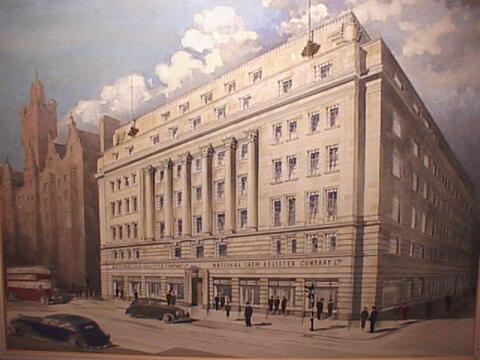
This original watercolour measuring 72 x 52 cm was commissioned to show what the proposed building would looked like when completed.
The painting in a 100 x 80 cm gilt frame is now owned by Ian Ormerod.